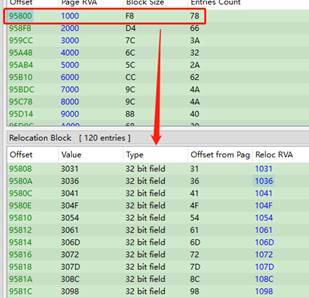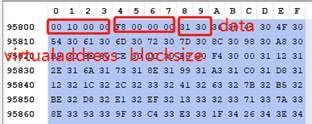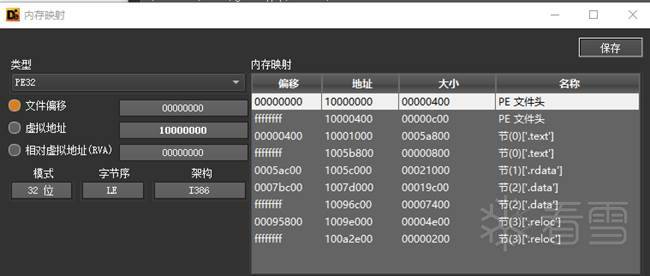奇安信的报告《使用和海莲花相似混淆手法的攻击样本分析》[1]中分析了一个和APT32使用相同混淆方法的样本。本文根据奇安信的报告以及报告中提到的参考文章和代码[2]对该样本进行去混淆。
SHA256:bf3e495f43a6b333b10ae69667304cfd2c87e9100de9d31365671c7b6b93132e
如下图所示,cmp/test指令将数据段中存储的数据与立即数进行比较,下一条指令是条件跳转指令,根据比较结果来决定是否发生跳转。恶意代码通过这种方式来混淆控制流,影响分析人员进行逆向分析。

图 1-1 混淆代码
解决方法:
该dll当前载入的基址是0x10000000,与立即数(operation_2)进行比较的数据存储在地址operation_1(0x1007EE93),如果dll载入基址发生变化,则operation_1也会相应发生变化。为了使dll在基址发生改变时也能正确获取数据,使用dword_1007EE93的地址被记录在了重定位表中,当基址发生变化时,程序会根据重定位表中的地址修改operation_1。重定位表中保存了一大堆需要修正的代码的地址。
我们可以获取重定位表中存储的地址信息,通过判断该地址前面的指令是否为cmp/test来确定混淆指令的地址。模拟执行cmp/test、跳转指令后获取之后执行的指令地址。通过判断是否发生了跳转,将对应指令替换成NOP。
使用python的pefile库获取重定位表中存储的RVA。

图 2-1 重定位表
重定位表由数个IMAGE_BASE_RELOCATION结构组成,每个结构由VirutalAddress(DWORD)、SizeOfBlock(DWORD)和TypeOffset(SizeOfBlock-8)组成。重定位数据2个字节一组,高4位是类型,低12位是地址。低12位加上VirutalAddress是RVA。以第一个数据0x3031为例,低12位是0x031,加上0x1000,是0x1031。


parse_relocations_directory返回BaseRelocationData对象列表。BaseRelocationData有两个属性,struct和entries。struct是IMAGE_BASE_RELOCATION结构的VA和Size。entries是RelocationData对象列表,每一个RelocationData包含type和RVA,RVA是低12位加上VirutalAddress后的值。

图 2-2 BaseRelocationData的struct和RelocationData对象列表

图 2-3 重定位数据的RVA
reloc_data_rva列表中存储所有重定位数据RVA。
本部分代码引用自
https://github.com/levanvn/APT32_Deobfuscate/blob/master/Type2/Script/Type2_Deobfuscate.py
混淆指令有以下5种情况。





图 2-4 混淆指令
在默认操作数是32 位的OS 上,任何操作word 的指令都较操作dword 的指令长一个字节(Prefixes 0x66)。操作数前面的机器码长度是2到3字节。从使用重定位数据的地址往前3个字节或2个字节进行汇编,判断指令是否为cmp/test和跳转指令,如果是就获取到了混淆指令所在地址。
设置初值b为3,获取数据,如果往前3个字节开头是0x66,b减1,判断汇编代码,符合条件返回地址, reloc_data_rva - b – 1。如果开头不是0x66,b减1,判断往前2个字节的汇编代码,符合条件返回地址。
PE文件头中的FileAlignment定义了磁盘区块的对齐值,SectionAlignment定义了内存中区块的内存值。每一个区块从对齐值的倍数的偏移位置开始。

图 2-5 对齐值

图 2-6 文件映射到内存中的地址
pefile库中的函数get_memory_mapped_image()可以返回与PE文件的内存布局对应的数据
获取到混淆指令所在地址后,模拟执行3条指令,cmp/test、跳转指令和第3条指令,记录第3条指令的地址。
使用count对执行的指令进行计数,将count存储在esp寄存器中。如果执行完3条指令,则记录第3条指令地址,退出模拟执行。
跳转结果存储在instruction_3列表中。
假设所有混淆指令的执行结果都是不跳转,通过顺序执行ins_3 = next(ins)的方式获取第3条指令的地址。将获取到的地址与模拟执行结果instruction_3列表中的地址进行比较,如果相等,则并未发生跳转,如果不相等则发生了跳转。顺序执行时有的地址无法进行汇编,将地址值赋值为0。
未发生跳转则将混淆指令test/cmp + 跳转指令赋值为0x90,发生跳转,则将混淆指令与目的跳转地址中间的数据全部赋值为0x90,中间的数据是垃圾数据,如果只将js等指令替换成“jmp 目的地址”,会影响程序的反汇编。
使用函数set_bytes_at_rva(rva, data)修改PE 映像中的数据,并写入文件
[1]. 使用和海莲花相似混淆手法的攻击样本分析
https://ti.qianxin.com/blog/articles/Obfuscation-techniques-similar-to-OceanLotus/
[2]. Type2_Deobfuscate.py
https://github.com/levanvn/APT32_Deobfuscate/blob/master/Type2/Script/Type2_Deobfuscate.py
[3]. pefile.py
https://github.com/erocarrera/pefile/blob/master/pefile.py
[4]. 菜鸟读capstone与keystone源码入门
https://bbs.pediy.com/thread-258473-1.htm
[5]. Unicorn引擎教程
https://bbs.pediy.com/thread-224330.htm#msg_header_h3_7
reloc_table_num = pefile.DIRECTORY_ENTRY['IMAGE_DIRECTORY_ENTRY_BASERELOC']
reloc_table = pe.OPTIONAL_HEADER.DATA_DIRECTORY[reloc_table_num]
reloc_table_rva = reloc_table.VirtualAddress
reloc_table_size = reloc_table.Size
print(f'重定位表RAV:{reloc_table_rva:#x},重定位表大小:{reloc_table_size:#x}')
reloc_table_num = pefile.DIRECTORY_ENTRY['IMAGE_DIRECTORY_ENTRY_BASERELOC']
reloc_table = pe.OPTIONAL_HEADER.DATA_DIRECTORY[reloc_table_num]
reloc_table_rva = reloc_table.VirtualAddress
reloc_table_size = reloc_table.Size
print(f'重定位表RAV:{reloc_table_rva:#x},重定位表大小:{reloc_table_size:#x}')
relocations = pe.parse_relocations_directory(reloc_table_rva, reloc_table_size)
reloc_data_rva = []
for i in relocations:
for j in i.entries:
reloc_data_rva.append(j.rva)
relocations = pe.parse_relocations_directory(reloc_table_rva, reloc_table_size)
reloc_data_rva = []
for i in relocations:
for j in i.entries:
reloc_data_rva.append(j.rva)
class BaseRelocationData(DataContainer):
class RelocationData(DataContainer):
class BaseRelocationData(DataContainer):
class RelocationData(DataContainer):
branch = ["JZ", "JP", "JO", "JS", "JG", "JB", "JA", "JL", "JE", "JNZ", "JNP", "JNO", "JNS", "JLE", "JNB", "JBE",
"JGE", "JNE", "JAE"]
b = 3
for i in range(3):
code = memory_data[reloc_data_rva - b: reloc_data_rva - b + 40]
if b == 3 and code[0] != 0x66:
b = b - 1
continue
b = b - 1
try:
ins = md.disasm(code, ImageBase + reloc_data_rva-b-1)
ins_1 = next(ins)
ins_2 = next(ins)
ins.close()
except StopIteration:
continue
if (ins_1.mnemonic == 'cmp' or ins_1.mnemonic == 'test') and ins_2.mnemonic.upper() in branch \
and len(ins_1.operands) == 2 and ins_1.operands[0].type == X86_OP_MEM and ins_1.operands[1].type == X86_OP_IMM:
return return ins_1.address-0x10000000
return 0
branch = ["JZ", "JP", "JO", "JS", "JG", "JB", "JA", "JL", "JE", "JNZ", "JNP", "JNO", "JNS", "JLE", "JNB", "JBE",
"JGE", "JNE", "JAE"]
b = 3
for i in range(3):
code = memory_data[reloc_data_rva - b: reloc_data_rva - b + 40]
if b == 3 and code[0] != 0x66:
b = b - 1
continue
b = b - 1
try:
ins = md.disasm(code, ImageBase + reloc_data_rva-b-1)
ins_1 = next(ins)
ins_2 = next(ins)
ins.close()
except StopIteration:
continue
if (ins_1.mnemonic == 'cmp' or ins_1.mnemonic == 'test') and ins_2.mnemonic.upper() in branch \
and len(ins_1.operands) == 2 and ins_1.operands[0].type == X86_OP_MEM and ins_1.operands[1].type == X86_OP_IMM:
return return ins_1.address-0x10000000
return 0
pe = pefile.PE(filename, fast_load=True)
content = pe.get_memory_mapped_image()
mu.mem_write(0x10000000, pe.get_memory_mapped_image())
pe = pefile.PE(filename, fast_load=True)
content = pe.get_memory_mapped_image()
mu.mem_write(0x10000000, pe.get_memory_mapped_image())
instruction_3 = []
def hook_code(mu, address, size, userdata):
print(f'>>> Tracing instruction at {address:#x}, instruction size = {size:#x}')
r_esp = mu.reg_read(UC_X86_REG_ESP)
count = u32(mu.mem_read(r_esp + 4, 4))
print(f'count is {count}')
if count == 2:
instruction_3.append(address)
mu.emu_stop()
try:
exit()
except BaseException as e:
print(e)
count = count + 1
mu.mem_write(r_esp + 4, p32(count))
def simulate_execute(ins_addr_rva):
mu.mem_write(r_esp + 4, p32(0))
mu.emu_start(ins_addr_rva + ImageBase, 0x100066E6)
instruction_3 = []
def hook_code(mu, address, size, userdata):
print(f'>>> Tracing instruction at {address:#x}, instruction size = {size:#x}')
r_esp = mu.reg_read(UC_X86_REG_ESP)
count = u32(mu.mem_read(r_esp + 4, 4))
print(f'count is {count}')
if count == 2:
instruction_3.append(address)
mu.emu_stop()
try:
exit()
except BaseException as e:
print(e)
count = count + 1
mu.mem_write(r_esp + 4, p32(count))
def simulate_execute(ins_addr_rva):
mu.mem_write(r_esp + 4, p32(0))
mu.emu_start(ins_addr_rva + ImageBase, 0x100066E6)
reloc_data_rva = get_reloc_data_rva(pe)
for rva in reloc_data_rva:
ins_addr_rva = get_intruction_start_rva(memory_mapped_image, rva, ImageBase)
if ins_addr_rva != 0:
simulate_execute(ins_addr_rva)
reloc_data_rva = get_reloc_data_rva(pe)
for rva in reloc_data_rva:
ins_addr_rva = get_intruction_start_rva(memory_mapped_image, rva, ImageBase)
if ins_addr_rva != 0:
simulate_execute(ins_addr_rva)
code = memory_mapped_image[ins_addr_rva:ins_addr_rva+40]
ins = md.disasm(code, ImageBase + ins_addr_rva)
ins_1 = next(ins)
ins_2 = next(ins)
try:
ins_3 = next(ins)
ins_3_address = ins_3.address
except:
ins_3_address = 0
ins.close()
code = memory_mapped_image[ins_addr_rva:ins_addr_rva+40]
ins = md.disasm(code, ImageBase + ins_addr_rva)
ins_1 = next(ins)
ins_2 = next(ins)
try:
ins_3 = next(ins)
ins_3_address = ins_3.address
except:
ins_3_address = 0
ins.close()
if instruction_3[count] == ins_3_address:
size = ins_1.size + ins_2.size
assembly = b'\x90' * size
patch(memory_mapped_image, ImageBase, ImageBase + ins_addr_rva, assembly)
else:
size = instruction_3[count] - ins_1.address
assembly = b'\x90' * size
patch(memory_mapped_image, ImageBase, ImageBase + ins_addr_rva, assembly)
count = count + 1
if instruction_3[count] == ins_3_address:
size = ins_1.size + ins_2.size
assembly = b'\x90' * size
patch(memory_mapped_image, ImageBase, ImageBase + ins_addr_rva, assembly)
else:
size = instruction_3[count] - ins_1.address
assembly = b'\x90' * size
patch(memory_mapped_image, ImageBase, ImageBase + ins_addr_rva, assembly)
count = count + 1
for section in pe.sections:
print(f'{section.Name}, VirtualAddress: {section.VirtualAddress:#x}, '
f'Size: {section.SizeOfRawData:#x}, 文件偏移: {section.PointerToRawData:#x}')
pe.set_bytes_at_rva(section.VirtualAddress,
bytes(memory_mapped_image[section.VirtualAddress:section.VirtualAddress + section.SizeOfRawData]))
print('[+] Save to file ' + '1.bin')
pe.write('1.bin')
for section in pe.sections:
print(f'{section.Name}, VirtualAddress: {section.VirtualAddress:#x}, '
f'Size: {section.SizeOfRawData:#x}, 文件偏移: {section.PointerToRawData:#x}')
pe.set_bytes_at_rva(section.VirtualAddress,
bytes(memory_mapped_image[section.VirtualAddress:section.VirtualAddress + section.SizeOfRawData]))
print('[+] Save to file ' + '1.bin')
pe.write('1.bin')
import pefile
import struct
from capstone.x86 import *
from capstone import *
from unicorn import *
from unicorn.x86_const import *
from binascii import *
def u32(data):
return struct.unpack("I", data)[0]
def p32(num):
return struct.pack("I", num)
def patch(image, image_base, address, patch_data):
i = 0
for b in patch_data:
image[address - image_base + i] = b
i += 1
def get_reloc_data_rva(pefile_struct):
reloc_table_num = pefile.DIRECTORY_ENTRY['IMAGE_DIRECTORY_ENTRY_BASERELOC']
reloc_table = pe.OPTIONAL_HEADER.DATA_DIRECTORY[reloc_table_num]
reloc_table_rva = reloc_table.VirtualAddress
reloc_table_size = reloc_table.Size
print(f'重定位表RAV:{reloc_table_rva:#x},重定位表大小:{reloc_table_size:#x}')
relocations = pe.parse_relocations_directory(reloc_table_rva, reloc_table_size)
reloc_data_rva = []
for i in relocations:
for j in i.entries:
reloc_data_rva.append(j.rva)
return reloc_data_rva
def get_intruction_start_rva(memory_data, reloc_data_rva, ImageBase):
branch = ["JZ", "JP", "JO", "JS", "JG", "JB", "JA", "JL", "JE", "JNZ", "JNP", "JNO", "JNS", "JLE", "JNB", "JBE",
"JGE", "JNE", "JAE"]
b = 3
for i in range(3):
code = memory_data[reloc_data_rva - b: reloc_data_rva - b + 40]
if b == 3 and code[0] != 0x66:
b = b - 1
continue
b = b - 1
try:
ins = md.disasm(code, ImageBase + reloc_data_rva-b-1)
ins_1 = next(ins)
ins_2 = next(ins)
ins.close()
except StopIteration:
continue
if (ins_1.mnemonic == 'cmp' or ins_1.mnemonic == 'test') and ins_2.mnemonic.upper() in branch \
and len(ins_1.operands) == 2 and ins_1.operands[0].type == X86_OP_MEM and ins_1.operands[
1].type == X86_OP_IMM:
return ins_1.address-0x10000000
return 0
filename = 'bf3e495f43a6b333b10ae69667304cfd2c87e9100de9d31365671c7b6b93132e'
pe = pefile.PE(filename, fast_load=True)
memory_mapped_image = bytearray(pe.get_memory_mapped_image())
ImageBase = pe.OPTIONAL_HEADER.ImageBase
print('[+] Map PE')
BASE = 0x10000000
STACK_ADDR = 0x400000
STACK_SIZE = 1024 * 1024
mu = Uc(UC_ARCH_X86, UC_MODE_32)
mu.mem_map(BASE, 1024 * 1024)
mu.mem_map(STACK_ADDR, STACK_SIZE)
r_esp = STACK_ADDR + STACK_SIZE // 2
mu.reg_write(UC_X86_REG_ESP, STACK_ADDR + STACK_SIZE // 2)
mu.mem_write(0x10000000,pe.get_memory_mapped_image())
md = Cs(CS_ARCH_X86, CS_MODE_32)
md.detail = True
instruction_3 = []
def hook_code(mu, address, size, userdata):
print(f'>>> Tracing instruction at {address:#x}, instruction size = {size:#x}')
r_esp = mu.reg_read(UC_X86_REG_ESP)
count = u32(mu.mem_read(r_esp + 4, 4))
print(f'count is {count}')
if count == 2:
instruction_3.append(address)
mu.emu_stop()
try:
exit()
except BaseException as e:
print(e)
count = count + 1
mu.mem_write(r_esp + 4, p32(count))
mu.hook_add(UC_HOOK_CODE, hook_code)
def simulate_execute(ins_addr_rva):
mu.mem_write(r_esp + 4, p32(0))
mu.emu_start(ins_addr_rva + ImageBase, 0x100066E6)
reloc_data_rva = get_reloc_data_rva(pe)
ins_addr_rva_all = []
count = 0
for rva in reloc_data_rva:
ins_addr_rva = get_intruction_start_rva(memory_mapped_image, rva, ImageBase)
if ins_addr_rva != 0:
ins_addr_rva_all.append(ins_addr_rva)
simulate_execute(ins_addr_rva)
code = memory_mapped_image[ins_addr_rva:ins_addr_rva+40]
ins = md.disasm(code, ImageBase + ins_addr_rva)
ins_1 = next(ins)
ins_2 = next(ins)
try:
ins_3 = next(ins)
ins_3_address = ins_3.address
except:
ins_3_address = 0
ins.close()
if instruction_3[count] == ins_3_address:
size = ins_1.size + ins_2.size
assembly = b'\x90' * size
patch(memory_mapped_image, ImageBase, ImageBase + ins_addr_rva, assembly)
else:
size = instruction_3[count] - ins_1.address
assembly = b'\x90' * size
patch(memory_mapped_image, ImageBase, ImageBase + ins_addr_rva, assembly)
count = count + 1
for section in pe.sections:
print(f'{section.Name}, VirtualAddress: {section.VirtualAddress:#x}, '
f'Size: {section.SizeOfRawData:#x}, 文件偏移: {section.PointerToRawData:#x}')
pe.set_bytes_at_rva(section.VirtualAddress,
bytes(memory_mapped_image[section.VirtualAddress:section.VirtualAddress + section.SizeOfRawData]))
print('[+] Save to file ' + '1.bin')
pe.write('1.bin')
import pefile
import struct
from capstone.x86 import *
from capstone import *
from unicorn import *
from unicorn.x86_const import *
from binascii import *
def u32(data):
return struct.unpack("I", data)[0]
def p32(num):
return struct.pack("I", num)
def patch(image, image_base, address, patch_data):
i = 0
for b in patch_data:
image[address - image_base + i] = b
[招生]科锐逆向工程师培训(2024年11月15日实地,远程教学同时开班, 第51期)